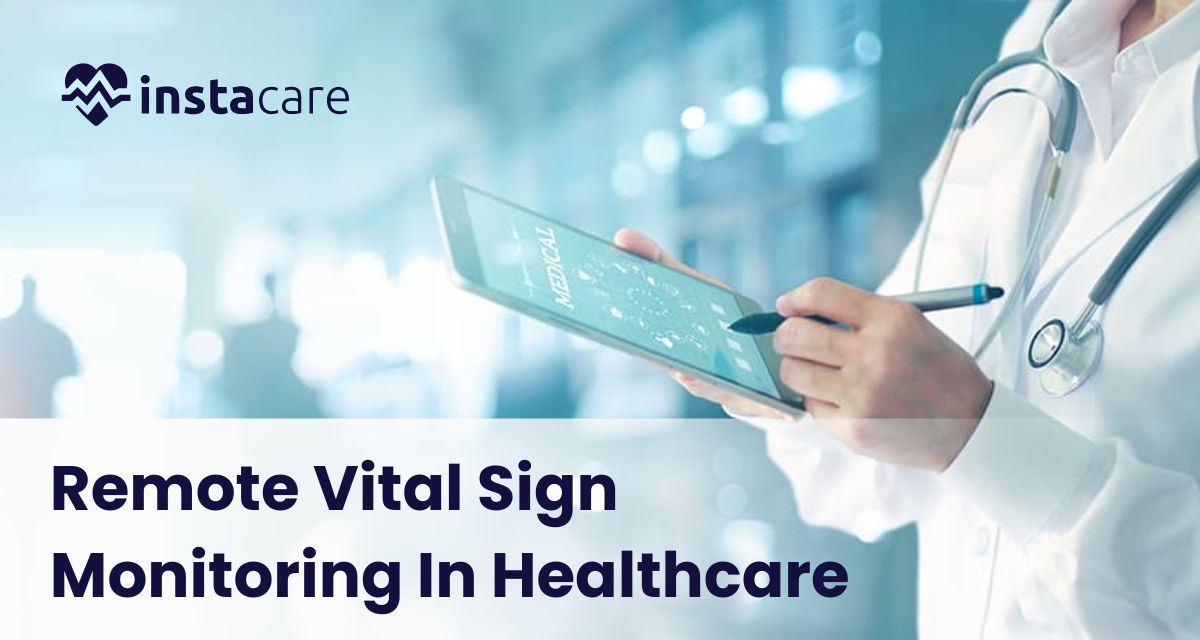Last updated on Friday, 29, March, 2024
Table of Contents
Benefits Of Remote Vital Sign Monitoring In Healthcare
Today’s healthcare system is continuously changing, with technology integration as its backbone. Patient care has entirely new dynamics, which has brought a new way of healthcare management. Another area where high technologies have had a significant impact is remote vital sign monitoring, which has rapidly become very popular in the last few years.
For remote monitoring of patients’ vital organs, healthcare providers can monitor home-side patients’ heart rate, blood pressure, and blood oxygen levels from some miles away. In this comprehensive article, we will indeed cover the reasons why it is necessary, the private or professional needs the monitoring may fulfil, and its positive effects on healthcare services.
Importance Of Remote Vital Sign Monitoring
- Early Detection Of Health Issues: Remote vital sign monitoring permits healthcare staff to monitor patients’ vital sign feeds and detect continuously, in time, any deviation from the standard values. As such, this strategy promotes timely interference when health problems are first identified, thus keeping the severity of the issues in control for the patient’s benefit.
- Chronic Disease Management: Patients with conditions like hypertension, diabetes, and heart complications need frequent monitoring, particularly of their vital signs, to control their conditions properly. Remote vital sign monitoring allows patients to master their health by means of immediate feedback and alerts sent to healthcare providers, thereby permitting the adoption of proactive management of chronic conditions.
- Reduced Healthcare Costs: By prompting preventive care and stopping emergency room visits or needless hospitalizations, remote vital sign monitoring is a payment-efficient option for combating chronic conditions. Furthermore, it provides more practical guidelines for healthcare entities to achieve success in healthcare delivery without overburdening healthcare establishments and staff.
- Enhanced Patient Engagement: Through remote vital sign monitoring, citizens are more encouraged and enthusiastic to assume control of their health and be accountable for managing it. Patients can now organise themselves by measuring their vital indices themselves, fostering treatment adherence, and communicating with their healthcare providers. This form of shared leadership delivers the feeling of influence and improves the level of patient satisfaction.
Uses Of Remote Vital Sign Monitoring
1-Post-Discharge Monitoring
Following discharge from the hospital, patients are entitled to particular concerns, including follow-up programs, which will ensure their condition progresses without any complications and reduce readmissions. The conditions are made more favourable by the remote monitoring of vital signs, where physicians can view patients’ vital signs in real-time, making rapid interventions possible in the event of problems.
2-Home Health Monitoring
Health monitoring with remote devices for vital signs is essential in the care of individuals with chronic conditions and those requiring long-term care. These smart devices have helped patients in their health monitoring right within their home’s confines, which in turn has reduced the need for going to a clinic often and improved overall health.
3-Telemedicine Consultations
Virtual doctor-patient consultations in the age of telemedicine are greatly enhanced by remote vital sign monitoring, meaning that crucial information can be acquired remotely. Every patient can send their vital sign data to healthcare providers in real-time, which is then used by doctors for precise diagnoses. The patients found to be in need are treated without the need for in-person visits.
4-Clinical Research And Trials
Remote vital signs monitoring is increasingly used in research and trials to measure subjects’ data in real-time. This equips investigators with valuable information about participants’ general conditions and reactions to different procedures, helping make clinical studies more precise and fast.
View More: Maximizing Efficiency with Smart Clinic Software
The Main Advantages Of Remote Vitals Monitoring
Let’s dive deeper into the value added as well as key benefits of remote vital monitoring.
1-Increased Availability Of Value-Based Care
By abandoning the former fee-for-service reimbursement system, the value-based care model links financial reimbursement to the quality of patient care. Value-based care implementation is a practical approach that leads to better patient outcomes with reduced costs, but the health system faces some obstacles.
- Resource shortage is one of the most pressing problems facing organizations that would like to implement value-based care.
- Remote vitals monitoring simplifies the task of providers by allowing them to expand their capacity.
- By using virtual visits and remote vital monitoring, providers can complete more tasks in less time and dedicate more of their energy to the patients with the highest risk of failure.
- Overall, each telehealth nurse can monitor 80 to 100 patients, depending on the number of clients.
2-Improved Patient Outcomes
Monitoring parameters like heart rate, blood pressure, and blood sugar still necessitates booking a face-to-face appointment with the doctor. It can be stressful for those who have to take time off from work or arrange their family members for transportation. Yet, the adoption of remote monitoring technology allows patients to share their vitals using Bluetooth-enabled biometric devices from their homes, so it becomes more convenient for patients and family caregivers to have a more significant say in the management of health, thus bettering health outcomes.
3-Healthcare Cost Savings
Remote monitoring of vital signs can significantly reduce unnecessary ER visits, avoidable hospitalizations, and readmissions, reducing healthcare costs. The essential monitoring devices can make the patient realize the severity of his disease, and the risk alerts may send a message to the care providers about the rising patient risk. This enables doctors to assess their patients and intervene promptly without unnecessary expenses and hospital admissions.
4-Enhanced Patient Engagement
In the conventional healthcare setting, care ceases as soon as a patient leaves the doctor’s clinic until the moment of the subsequent attendance. Without a sense of observation of what is happening with the patients, the staff participating in the care can no longer be at arm’s length. Patients can only accommodate advisory skills and are not responsible for compliance.
The physical audience is the interface that prevents healthcare providers from conducting real-time observation when remote monitoring is used, as opposed to this obstacle being removed with real-time observation.
Reallocation Of Healthcare Providers’ Time To More Fruitful Areas Such As Preventive Care And Chronic Disease Management
Through remote health monitoring, patients can cut down on ER visits and stay better out of hospitals, making it possible to have a better use of medics’ time with those patients who actually need their help. Remote monitoring plays a big part in task thinning in the face of the significant problem of nursing shortage by making healthcare delivery as efficient and streamlined as possible. The providers are able to carefully place their staff in this case, who will then support the most susceptible patients and, at the same time, watch over the ones with chronic conditions from afar.
Wrapping Up!
Remote vital sign monitoring is a transformative technology that has the capability of bringing a new era in healthcare, which is entirely different from the treatment approaches that we have always been used to. InstaCare is a crucial player at the cutting edge of the wave of the technological revolution with its innovative home monitoring technologies that provide patients with the tools to be part of healthcare delivery.
FAQs
How do I set a remote vital sign monitoring for myself or one of my dear ones in motion at home or back at my house?
You can move to start this remote vital sign monitoring by getting in touch with your healthcare team or the remote monitoring service provider. They can suggest movable monitors, establish the monitoring system, and give an insight into how to record the data well and interpret it correctly.
What are the drawbacks of non-priciest health assessment?
Along with the advantages of remote virtual sign classification, remote virtual sign checking also undoubtedly has defects.
What is the best place where I can learn about vital sign monitoring over a long distance?
If you need to know about remote vital sign monitoring, contact your doctor, explore certified medical technology websites, or call remote monitoring service providers for assistance.



